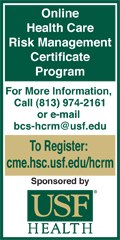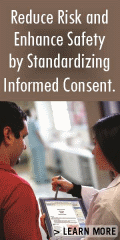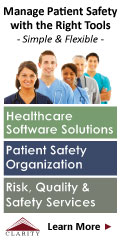 |
 |
 |

July / August 2008

The Leapfrog Group's CPOE Standard and Evaluation Tool
By Jane B. Metzger, BA; Emily Welebob, RN, MS;
Fran Turisco, BES, MBA; and David C. Classen, MD, MS
Much of the increased focus on improving patient safety in healthcare, which started gaining momentum following the Institute of Medicine's (IOM) 1999 report To Err Is Human: Building a Safer Health System*, has centered on preventing medication-related adverse events (ADEs). In its call to action, the IOM targeted medication errors as one of the highest priority gaps in care and recognized the important role information technology such as computerized physician order entry (CPOE) could play in closing the gap. In the last 15 years, both the problem of medication errors and ADEs and implementing CPOE as part of the solution have received heightened attention, though progress with CPOE has been slow.
* Published by National Academy Press in 2000.
In 2002, the National Quality Forum (NQF) designated medication errors resulting in harm as one type of preventable error that should never happen to any patient and, therefore, requiring high-priority attention in hospital quality improvement programs. Increasingly, hospital data on "never events" is being made available in public reporting, and payers are moving toward not reimbursing for care that results from a never event.
New evidence has also revealed more about the frequency and consequences of medication-related adverse events in the hospital. One recent in-depth look at the issue through chart reviews in five community hospitals found that 1 in 10 patients suffers a serious medication-related adverse event and, further, that CPOE with appropriate clinical decision support guiding and critiquing ordering could likely prevent 81% of the events (Adams et al., 2008). Rounding out the early research on adult patients (which was often cited in the 1999 IOM report), a more recent examination of adverse events in pediatric patients revealed that the rate is three times higher (though CPOE could potentially assist in preventing 93%; Kaushal et al., 2001).
Implementing CPOE with a concerted effort to improve process and use decision support as an additional safety net continues to be recommended by many organizations as a necessary investment for improving patient safety, in particular medication safety. CPOE was adopted by The Leapfrog Group (Leapfrog) in 2000 as one of its first three breakthrough improvements ("leaps") in patient safety. Leapfrog has been collecting and making available to the public hospital-specific status reports on adopting CPOE and other safety leaps through The Leapfrog Group Hospital Quality and Safety Survey since 2001. In 2003, the members of NQF reached consensus on an initial set of 27 safe practices that included "implement[ing] a computer prescriber order entry system." The IOM (2003) has also defined CPOE as a critical element of the electronic health record, a necessary technology for delivering safe care. More recently the Certification Commission for Health Information Technology (CCHIT) focused initial certification of inpatient clinical systems on the applications offering the most value in addressing medication errors — CPOE and electronic medical administration record with related clinical decision support and medication reconciliation — because these areas have the greatest potential for major improvements in patient safety and quality, especially medication safety.
Despite the urgency of reducing medication-error-related ADEs and the continued push for widespread CPOE adoption, progress has been slow because of the scope, complexity, and cost of the effort. The latest tally from the Leapfrog survey, covering 1,300 participating hospitals in the 33 regions currently targeted by Leapfrog employer groups, shows that 10.7% meet the Leapfrog standard: physicians write 75% of medication orders in CPOE (2008). A 2007 American Hospital Association survey of 1,500 community hospitals showed a slightly lower 8% rate of adoption (defined as 75% of physicians entering medication orders for their hospital patients).
The Leapfrog CPOE Standard
The Leapfrog Group is a voluntary program of large employers seeking to mobilize a combination of public awareness and rewards to higher-quality providers to accomplish breakthrough improvements (big "leaps") in patient safety. Members now include many of the nation's largest employers and public agencies that buy health benefits for more than 35 million Americans (Leapfrog Group, Fact Sheet).
The "leaps" selected meet four criteria:
- be associated with scientific evidence that they will significantly reduce medical mistakes,

- their implementation is feasible in the near term,

- consumers can readily appreciate their value, and

- purchasers and consumers can easily ascertain their presence or absence when selecting healthcare providers.
The CPOE standard was one of the first three leaps because medication errors have tragic consequences for so many patients and result in tremendous financial costs (Leapfrog Group, Fact Sheet: CPOE).
The intent of the CPOE standard is to promote the use of CPOE with clinical decision support that can intercept erroneous and dangerous medication orders.
The testing protocol first became available in May 2008 to hospitals that complete the Leapfrog survey (posted results for 2008 only show that the hospital completed the CPOE evaluation.) Separate evaluations are available for pediatric and adult care, and hospitals complete one or both, depending upon the patient population served. In 2009, results will be posted (in quarter moon, half moon format) and factored into determining which hospitals meet the standard.
Mention of a testing protocol in the standard recognizes that it is important to verify the extent to which the CPOE system in use actually intercepts problematic medication orders. "Toolset" is an appropriate term to describe the CDS functions in a CPOE application. Some vendors provide starter sets (for order sets or laboratory tests for duplicate checking, for example), and some tools are designed to be relatively easy to set up and use. However, CDS tools are not in a state that allows them to simply be turned on. Rather significant work lies ahead for designated individuals and groups in the hospital to determine how best to apply the tools, within local policy and practices, and to meet local safety and quality objectives. (For this reason, the Leapfrog CPOE evaluation focuses on implemented CPOE applications rather than vendor CPOE applications "out of the box" or "off the shelf".)
Work on the evaluation tool began in 2001, funded by the California Healthcare Foundation, Robert Wood Johnson Foundation, and the Agency for Healthcare Research and Quality. The objective was to provide a credible, remote CPOE evaluation methodology for hospitals to assess and self-report the extent to which the CDS tools as implemented aid physicians in avoiding common, serious medication errors (Leapfrog Group, Fact Sheet: CPOE; Kilbridge et al., 2001; AHRQ, 2007).
The evaluation mimics physician order writing in the hospital, using test patients and a set of test orders. Most hospitals can use a test system so long as it mirrors all of the order management functions and decision support in the production system. A web application for the evaluation has been added to the Leapfrog survey web site to disseminate instructions, test patients, and test orders and to capture hospital self-reported evaluation results (Kilbridge et al., 2001; AHRQ, 2007). Table 1 summarizes the process and the steps responsible staff in each hospital take to initiate and conduct the evaluation and report results. Time constraints are associated with each download of test information and reporting. A sample evaluation is available as a dry run.
| Table 1: Leapfrog CPOE Evaluation Tool Procedure |
| Steps in the Evaluation Procedure |
Activities |
| 1. |
Register for the CPOE evaluation. |
- Obtain the password used to participate in the Leapfrog survey.
- Sign on to the web application.
- Enter hospital information.
- Sign up for adult or pediatric evaluation.
- Assemble teams for patient set-up and order entry.
- Ensure test system mirrors production system or make plans to use production system.
|
| 2. |
Download test patient information (e.g., age, weight, allergies, lab values). |
- When ready to begin set-up for the sample test or full evaluation, sign on to the web application.
- Print list of test patients.
- Set up test patients.
- Ensure patients are "active" (may require nursing unit and bed before orders can be written and signed).
|
| 3. |
Download test orders. |
- When ready to begin the sample test or full evaluation, sign on to the Web application.
- Print test orders, instructions, and answer sheets.
- Ensure physician performing the evaluation has system authorizations required for order entry in CPOE (may be a test user).
|
| 4. |
Enter orders into CPOE application. |
- Enter test orders for specifi ed test patients.
- Sign every test order (or pair of orders)
- Record the system responses on the answer sheet.
- Discontinue each test order (or pair of orders).
|
| 5. |
Enter and submit results. |
- Sign on to the web application.
- Submit information from answer sheet as instructed.
|
| 6. |
Scoring |
- Automatic scoring of success in providing decision support to avert common, harmful
medication errors for each order category, and the evaluation overall.
|
| 7. |
Reporting |
- Print or view feedback report immediately available (scores for each order category).
- Aggregate score available for posting along with hospital survey results.
|
In addition to collecting information about compliance with the CPOE Leap, the evaluation provides the hospital a feedback report with scores for each of the order categories. This can help gauge progress so far in applying the CDS toolset as an additional safety net and refine plans for continued work to improve medication safety. Effective use of CDS requires not only a concerted effort, but also a new type of collaboration between information systems staff and the individuals and committees working to improve safety. A second article, to appear in the Sept/Oct issue, will review the challenges and how hospitals with CPOE are addressing them.
Jane Metzger has done research and consulting on bringing computer support to the point of care for the past 36 years. She is a principal in Emerging Practices, CSC's applied research arm. She has completed several studies on the successful adoption of CPOE in community hospitals and on using the clinical decision support tools in CPOE to improve patient safety and quality. She has also developed organizational readiness assessments and other tools that aid in planning for implementation of clinical IT that meets quality improvement objectives, including the development of the Leapfrog CPOE evaluation tool. Metzger may be contacted at jmetzger@fcg.com.
Emily Welebob has worked in leadership roles in clinical nursing, the clinical systems marketplace, and consulting related to clinical systems/EHRs for over 15 years, with a focus on patient safety. For the past 6 years, she was responsible for day-to-day management of the Leapfrog evaluation project in all phases. Welebob has published, lectured, and researched in the areas of clinical informatics and patient safety, including numerous efforts concerning CPOE. She is currently with the Indiana Health Information Exchange.
Fran Turisco is a principal in CSC Emerging Practices. Her more than 25-year career in health information technology includes programming, application implementation and management in delivery organizations, consulting, and research. Turisco's recent research areas include physician order entry/clinical decision support, mobile computing to support point of care use, planning for emerging technologies, and IT support to clinical research. As a member of the Leapfrog project core team, she was responsible for the development and testing of the Web application for the CPOE evaluation tool and a survey of the CPOE vendor marketplace.
David Classen is a vice president and chief medical officer of CSC — Healthcare. He is also an associate professor of medicine at the University of Utah and a consultant in infectious diseases at The University of Utah School of Medicine in Salt Lake City, Utah. Classen consults, nationally and internationally, and has authored numerous publications on the use of IT-facilitated process change, decision support, and epidemiologic techniques to improve medication safety. Classen serves as a member of advisory and working groups of the Institute of Medicine, Joint Commission, and National Quality Forum.
References
Adams, M., Bates, D. W., Coffman, G., & Everett, W. (2008). Saving lives, saving money. The imperative for computerized physician order entry in Massachusetts hospitals. Massachusetts Technology Collaborative and New England Healthcare Institute.
AHRQ National Resource Center for Health Information Technology. (2007, January 12). A national web conference on the First Consulting Group inpatient and ambulatory CPOE assessment tool. Retreived from http://healthit.ahrq.gov/portal/server.pt?open=514&objID=
5553&mode=2&holderDisplayURL=http://prodportallb.ahrq.gov:
7087/publishedcontent/publish/communities/a_e/events/events/
events/a_national_web_conference_on_the_first_consulting_group_
inpatient_and_ambulatory_cpoe_evaluation_tool.html
American Hospital Association. (2007). Continued progress: Hospital use of information technology. Chicago: Author.
CCHIT certification for inpatient electronic health records. Retrieved March 26, 2008, from http://www.cchit.org/certify/inpatient/index.asp
Institute of Medicine. (2000). To err is human: Building a safer health system. L. T. Kohn, J. M. Corrigan, M. S. Donaldson (Eds.). Washington, DC: National Academy Press, Washington, DC.
Institute of Medicine. (2003). Patient safety: Achieving a new standard of care. Washington, DC: National Academy Press.
Kaushal, R., Bates, D. W., Landrigan, C., Mckenna, K.J., Clapp, M. D., Federico, F., Golmann, D. A. (2001). Medication errors and adverse events in pediatric inpatients. JAMA, 285(16), 2114-2120.
Kilbridge, P., Welebob, E., & Classen, D. (2001, December). Overview of the Leapfrog Group Evaluation Tool for Computerized Physician Order Entry. Retreived from http://www.leapfroggroup.org/media/file/
Leapfrog-CPOE_Evaluation2.pdf.
The Leapfrog Group. (n.d.) Fact sheet: Computerized physician order entry. Retrieved March 26,2008, from http://www.leapfroggroup.org/media/file/
Leapfrog-Computer_Physician_Order_Entry_Fact_Sheet.pdf
The Leapfrog Group fact sheet. Retrieved March 26, 2008, from http://www.leapfroggroup.org/about_us/leapfrog-factsheet
Leapfrog Group survey data from The Leapfrog Group, March.26, 2008.
National Quality Forum. (2002). Serious reportable events. Washington, DC: Author. Retrieved March 26, 2008, from http://www.qualityforum.org/pdf/reports/sre.pdf.
National Quality Forum. (2003). Safe practices for better healthcare. Washington, DC: Author. Retrieved March 26, 2008, from http://www.qualityforum.org/pdf/reports/safe_practices.pdf
|
 |
 |
 |


















|
 |



